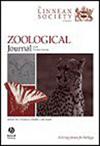叶蝉属(膜翅目:蜂科:叶蝉属)的分子种划分和历史生物地理学研究,重点研究了南美东部属
IF 2.8
2区 生物学
Q1 ZOOLOGY
引用次数: 0
摘要
无刺蜂属包括32种公认的物种,都是新热带地区的特有物种,从墨西哥到巴西南部。这项研究是第一个检查物种划分,系统发育关系,并在帕塔莫纳东部组的分化时间估计。在该组的21种中,有19种被纳入我们的分析。利用线粒体和细胞核标记,多物种合并模型鉴定出19个分子操作分类单位,其中13个完全符合最初定义的名义物种。我们发现东部帕塔莫纳群是单系的,由三个不同的分支组成,物种之间的关系与以前的分类有很大的不同。分化时间估计表明,东部类群起源于上新世,在更新世期间发生了大量的多样化,可能受到亚马逊地区雨林和干林分布变化以及河流屏障的影响。我们提出了三个主要的生物群系扩散事件。鉴于这些发现,有必要对该属,特别是东部分支进行全面的审查,以使用综合方法重新评估当前的分类。本文章由计算机程序翻译,如有差异,请以英文原文为准。
Molecular species delimitation and historical biogeography among species of the genus Partamona (Hymenoptera: Apidae: Meliponini), with emphasis on the Eastern group from South America
The stingless bees of the genus Partamona comprise 32 recognized species, all endemic to the Neotropical region, ranging from Mexico to southern Brazil. This study is the first to examine species delimitation, phylogenetic relationships, and divergence-time estimates within the Partamona Eastern group. Of the 21 species in this group, 19 were included in our analysis. Utilizing both mitochondrial and nuclear markers, a multispecies coalescence model identified 19 molecular operational taxonomic units, 13 of which correspond perfectly to the nominal species as initially defined. We find that the Partamona Eastern group is monophyletic and consists of three distinct clades, with relationships among species differing significantly from previous classifications. Divergence-time estimates suggest that the Eastern group originated in the Pliocene, with substantial diversification occurring during the Pleistocene, potentially influenced by shifts in rainforest and dry forest distributions and riverine barriers in the Amazon region. We propose three major dispersal events across biomes. Given these findings, a comprehensive review of the genus, particularly the Eastern clade, is necessary to reassess the current classification using an integrative approach.
求助全文
通过发布文献求助,成功后即可免费获取论文全文。
去求助
来源期刊
CiteScore
6.50
自引率
10.70%
发文量
116
审稿时长
6-12 weeks
期刊介绍:
The Zoological Journal of the Linnean Society publishes papers on systematic and evolutionary zoology and comparative, functional and other studies where relevant to these areas. Studies of extinct as well as living animals are included. Reviews are also published; these may be invited by the Editorial Board, but uninvited reviews may also be considered. The Zoological Journal also has a wide circulation amongst zoologists and although narrowly specialized papers are not excluded, potential authors should bear that readership in mind.

 求助内容:
求助内容: 应助结果提醒方式:
应助结果提醒方式:


